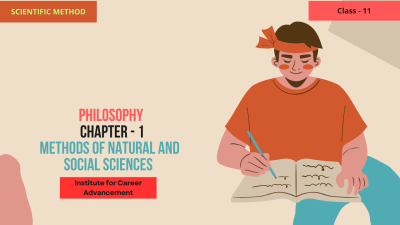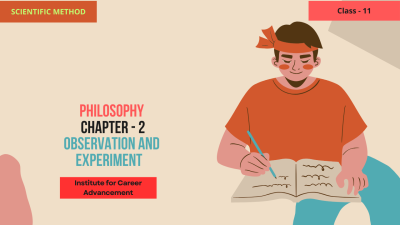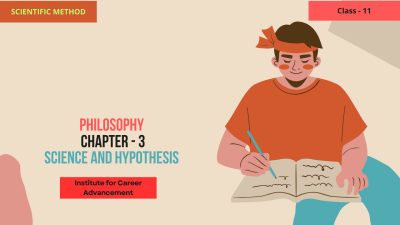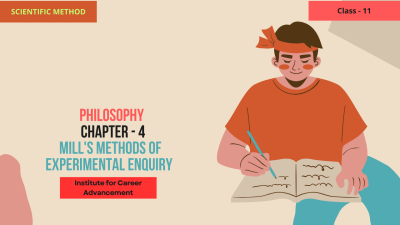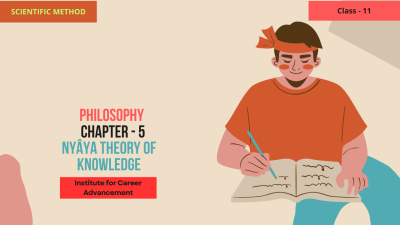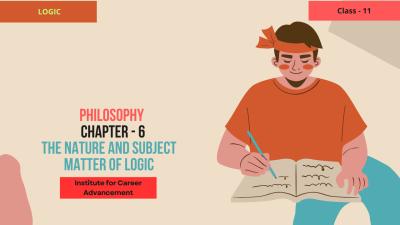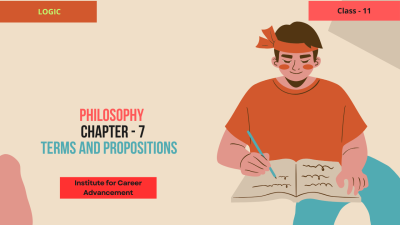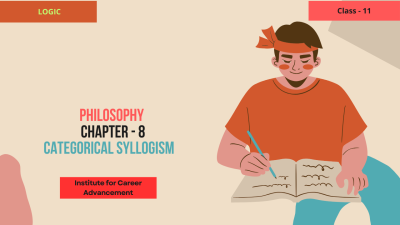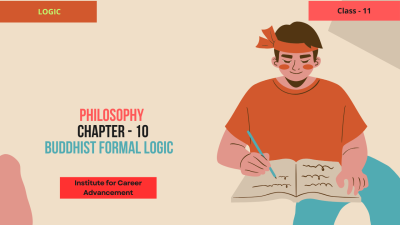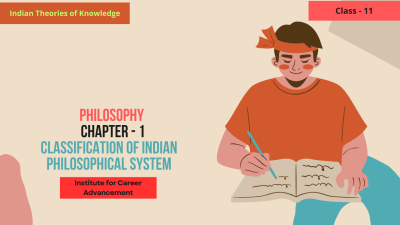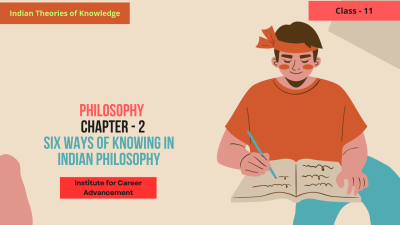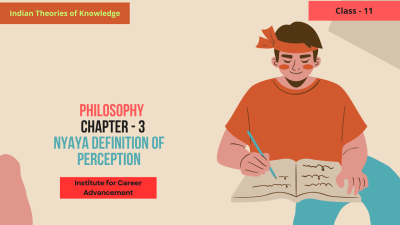Course description
The Buddhist view on indeterminate perception is an important aspect of Buddhist epistemology, which focuses on how knowledge is acquired, interpreted, and verified. In a Class 11 course, this topic explores how Buddhist philosophy addresses the limitations and nuances of perception, particularly regarding indeterminate or ambiguous experiences of reality. By understanding this concept, students gain insights into how Buddhist philosophers view the mind, perception, and the nature of reality, which often differs from other Indian schools like Nyaya and Vedanta.
Course Overview: Buddhist View on Indeterminate Perception
1. Introduction to Buddhist Epistemology
Objective: Students will be introduced to Buddhist epistemology, which investigates the nature of knowledge and how humans perceive reality. In Buddhism, knowledge is often linked to direct experience and the impermanence of all things.
Key Points:
Buddhism’s emphasis on impermanence and the dependence of perception on the mind and its conceptual processes.
Two main aspects of perception: Determinate perception (clear, direct knowledge) and indeterminate perception (ambiguous, unclear knowledge).
Buddhist thinkers such as Dignāga and Dharmakīrti play a key role in developing this concept.
2. What is Indeterminate Perception?
Objective: Students will understand the Buddhist perspective on indeterminate perception as knowledge that is unclear, uncertain, or not fully defined. This contrasts with determinate perception, which is clear, precise, and distinct.
Key Points:
Indeterminate perception: Occurs when the mind experiences sensory input but cannot immediately categorize or label the experience due to lack of clarity or ambiguous nature.
Example: Seeing a blur in the distance and not being sure if it is a tree or a person.
It refers to sensory experiences where the mind is unable to categorize the object or event with certainty.
3. The Nature of Indeterminate Perception in Buddhism
Objective: Students will learn how Buddhism views indeterminate perception as a natural and inevitable part of human perception due to the impermanence and subjectivity of all experiences.
Key Points:
Imperfect knowledge: Indeterminate perception is seen as a limitation of the human cognitive process.
Role of the mind: The mind's conceptual processes often distort or fail to accurately interpret sensory data, leading to indeterminate perception.
Dependency: Perception is dependent on mental constructs (such as labels, categories, and past experiences), meaning that even a seemingly clear perception can become ambiguous.
Relationship to Nirvana: Buddhist philosophy often links the nature of perception to the path to enlightenment. Overcoming indeterminate perceptions leads to clearer understanding of reality and the cessation of suffering (nirvana).
4. Buddhist Critique of Determinate Perception
Objective: Students will explore how Buddhist philosophers critique the idea of perfect, determinate perception, arguing that human perception is always subject to errors, biases, and mental conditioning.
Key Points:
Mental filters: Our perception is influenced by mental habits, attachments, and desires, which can distort the way we see things.
Subjectivity: Even determinate perceptions are seen as incomplete or subjective from a Buddhist standpoint, because they are still shaped by the individual's mind and ego.
Impermanence of perception: Perception is transient and not absolute; what we perceive as stable or determinate is always subject to change.
5. Examples and Applications of Indeterminate Perception
Objective: Students will identify examples of indeterminate perception in everyday life and how Buddhist principles can be applied to understand them.
Key Points:
Daily life: Common experiences such as uncertainty or hesitation about what is perceived (e.g., hearing an ambiguous sound, seeing a shape in the dark).
Meditative practice: Through mindfulness meditation, one learns to observe indeterminate perceptions without clinging to them, thus developing a more accurate understanding of reality.
Imperfect perceptions: Buddhist teachings emphasize recognizing that all perceptions, whether determinate or indeterminate, are incomplete and impermanent.
Summary
The Buddhist view on indeterminate perception in a Class 11 course focuses on the limitations of human perception and how this impacts our understanding of the world. Students will explore:
How indeterminate perception arises from unclear or ambiguous sensory input.
The role of the mind in interpreting sensory data and creating these ambiguities.
The relationship between impermanence, subjectivity, and knowledge in Buddhism.
The path to enlightenment as a way of overcoming distorted or indeterminate perceptions through mindfulness, meditation, and wisdom.
অনিশ্চিত উপলব্ধি সম্পর্কে বৌদ্ধ দৃষ্টিভঙ্গি বৌদ্ধ জ্ঞানতত্ত্বের একটি গুরুত্বপূর্ণ দিক, যা কীভাবে জ্ঞান অর্জন, ব্যাখ্যা এবং যাচাই করা হয় তার উপর দৃষ্টি নিবদ্ধ করে। একাদশ শ্রেণির কোর্সে, এই বিষয়টি বৌদ্ধ দর্শন কীভাবে উপলব্ধির সীমাবদ্ধতা এবং সূক্ষ্মতা, বিশেষত বাস্তবতার অনির্ধারিত বা দ্ব্যর্থহীন অভিজ্ঞতার বিষয়ে আলোচনা করে তা অন্বেষণ করে। এই ধারণাটি বোঝার মাধ্যমে, শিক্ষার্থীরা বৌদ্ধ দার্শনিকরা মন, উপলব্ধি এবং বাস্তবতার প্রকৃতিকে কীভাবে দেখেন সে সম্পর্কে অন্তর্দৃষ্টি অর্জন করে, যা প্রায়শই ন্যায় এবং বেদান্তের মতো অন্যান্য ভারতীয় বিদ্যালয়গুলির থেকে আলাদা। কোর্স ওভারভিউঃ অনির্ধারিত উপলব্ধি সম্পর্কে বৌদ্ধ দৃষ্টিভঙ্গি 1টি। বৌদ্ধ জ্ঞানতত্ত্বের পরিচিতি উদ্দেশ্যঃ শিক্ষার্থীদের বৌদ্ধ জ্ঞানতত্ত্বের সাথে পরিচয় করিয়ে দেওয়া হবে, যা জ্ঞানের প্রকৃতি এবং মানুষ কীভাবে বাস্তবতা উপলব্ধি করে তা তদন্ত করে। বৌদ্ধধর্মে, জ্ঞানকে প্রায়শই প্রত্যক্ষ অভিজ্ঞতা এবং সমস্ত কিছুর অস্থায়িত্বের সাথে যুক্ত করা হয়। মূল বিষয়গুলোঃ বৌদ্ধধর্মের অস্থায়িত্ব এবং মন এবং এর ধারণাগত প্রক্রিয়াগুলির উপর উপলব্ধির নির্ভরতার উপর জোর দেওয়া। উপলব্ধির দুটি প্রধান দিকঃ নির্ধারিত উপলব্ধি (স্পষ্ট, প্রত্যক্ষ জ্ঞান) এবং অনির্ধারিত উপলব্ধি (অস্পষ্ট, অস্পষ্ট জ্ঞান)। দিগনাগ ও ধর্মকীর্তি-র মতো বৌদ্ধ চিন্তাবিদরা এই ধারণার বিকাশে গুরুত্বপূর্ণ ভূমিকা পালন করেন। 2. অনির্ধারিত উপলব্ধি কী? উদ্দেশ্যঃ শিক্ষার্থীরা অনিশ্চিত উপলব্ধি সম্পর্কে বৌদ্ধ দৃষ্টিভঙ্গিকে এমন জ্ঞান হিসাবে বুঝতে পারবে যা অস্পষ্ট, অনিশ্চিত বা সম্পূর্ণরূপে সংজ্ঞায়িত নয়। এটি নির্ধারিত উপলব্ধির সঙ্গে বৈপরীত্যপূর্ণ, যা স্পষ্ট, সুনির্দিষ্ট এবং স্বতন্ত্র। মূল বিষয়গুলোঃ অনির্ধারিত উপলব্ধিঃ তখনই ঘটে যখন মন সংবেদনশীল ইনপুট অনুভব করে কিন্তু স্বচ্ছতার অভাব বা দ্ব্যর্থহীন প্রকৃতির কারণে অভিজ্ঞতাকে অবিলম্বে শ্রেণীবদ্ধ বা লেবেল করতে পারে না। উদাহরণস্বরূপঃ দূরে একটি অস্পষ্টতা দেখা এবং এটি কোনও গাছ বা কোনও ব্যক্তি কিনা তা নিশ্চিত না হওয়া। এটি সংবেদনশীল অভিজ্ঞতাকে বোঝায় যেখানে মন নিশ্চিতভাবে বস্তু বা ঘটনাকে শ্রেণীবদ্ধ করতে অক্ষম। 3. বৌদ্ধধর্মে অনির্ধারিত উপলব্ধির প্রকৃতি উদ্দেশ্যঃ সমস্ত অভিজ্ঞতার অস্থায়িত্ব এবং বিষয়গততার কারণে বৌদ্ধধর্ম কীভাবে অনির্দিষ্ট ধারণাকে মানুষের উপলব্ধির একটি প্রাকৃতিক এবং অনিবার্য অংশ হিসাবে দেখে তা শিক্ষার্থীরা শিখবে। মূল বিষয়গুলোঃ অসম্পূর্ণ জ্ঞানঃ অনির্ধারিত উপলব্ধি মানুষের জ্ঞানীয় প্রক্রিয়ার একটি সীমাবদ্ধতা হিসাবে দেখা হয়। মনের ভূমিকাঃ মনের ধারণাগত প্রক্রিয়াগুলি প্রায়শই সংবেদনশীল তথ্যকে বিকৃত করে বা সঠিকভাবে ব্যাখ্যা করতে ব্যর্থ হয়, যার ফলে অনির্ধারিত উপলব্ধি হয়। নির্ভরতাঃ উপলব্ধি মানসিক গঠনের উপর নির্ভরশীল (যেমন লেবেল, বিভাগ এবং অতীত অভিজ্ঞতা) যার অর্থ আপাতদৃষ্টিতে স্পষ্ট উপলব্ধিও অস্পষ্ট হয়ে উঠতে পারে। নির্বাণের সঙ্গে সম্পর্কঃ বৌদ্ধ দর্শন প্রায়শই উপলব্ধির প্রকৃতিকে আলোকপ্রাপ্তির পথের সঙ্গে যুক্ত করে। অনির্ধারিত উপলব্ধিগুলি অতিক্রম করা বাস্তবতা সম্পর্কে আরও স্পষ্ট বোঝার এবং দুঃখকষ্টের অবসান ঘটায় (নির্বাণ) 4. নির্ধারিত উপলব্ধির বৌদ্ধ সমালোচনা উদ্দেশ্যঃ শিক্ষার্থীরা বৌদ্ধ দার্শনিকরা কীভাবে নিখুঁত, নির্ধারিত উপলব্ধির ধারণার সমালোচনা করে তা অন্বেষণ করবে, এই যুক্তি দিয়ে যে মানুষের উপলব্ধি সর্বদা ত্রুটি, পক্ষপাত এবং মানসিক অবস্থার সাপেক্ষে। মূল বিষয়গুলোঃ মানসিক ফিল্টারঃ আমাদের উপলব্ধি মানসিক অভ্যাস, আসক্তি এবং আকাঙ্ক্ষা দ্বারা প্রভাবিত হয়, যা আমাদের জিনিসগুলি দেখার উপায়কে বিকৃত করতে পারে। বিষয়গততাঃ এমনকি নির্ধারিত উপলব্ধিগুলিকেও বৌদ্ধ দৃষ্টিকোণ থেকে অসম্পূর্ণ বা বিষয়গত হিসাবে দেখা হয়, কারণ সেগুলি এখনও ব্যক্তির মন এবং অহংকার দ্বারা গঠিত হয়। উপলব্ধির অপরিবর্তনীয়তাঃ উপলব্ধি ক্ষণস্থায়ী এবং পরম নয়; যা আমরা স্থিতিশীল বা নির্ধারিত হিসাবে উপলব্ধি করি তা সর্বদা পরিবর্তন সাপেক্ষে। 5. অনির্ধারিত উপলব্ধির উদাহরণ ও প্রয়োগ উদ্দেশ্যঃ শিক্ষার্থীরা দৈনন্দিন জীবনে অনির্ধারিত উপলব্ধির উদাহরণগুলি এবং সেগুলি বোঝার জন্য বৌদ্ধ নীতিগুলি কীভাবে প্রয়োগ করা যেতে পারে তা চিহ্নিত করবে। মূল বিষয়গুলোঃ দৈনন্দিন জীবনঃ সাধারণ অভিজ্ঞতা যেমন যা অনুভূত হয় সে সম্পর্কে অনিশ্চয়তা বা দ্বিধা (e.g., একটি অস্পষ্ট শব্দ শুনে, অন্ধকারে একটি আকৃতি দেখে) ধ্যানের অভ্যাসঃ মননশীল ধ্যানের মাধ্যমে, কেউ তাদের সাথে আঁকড়ে না থেকে অনির্ধারিত উপলব্ধিগুলি পর্যবেক্ষণ করতে শেখে, এইভাবে বাস্তবতা সম্পর্কে আরও সঠিক বোঝার বিকাশ ঘটে। অসম্পূর্ণ উপলব্ধিঃ বৌদ্ধ শিক্ষাগুলি এই স্বীকৃতির উপর জোর দেয় যে সমস্ত উপলব্ধি, নির্ধারিত বা অনির্ধারিত যাই হোক না কেন, অসম্পূর্ণ এবং অস্থায়ী। সারসংক্ষেপ একাদশ শ্রেণির কোর্সে অনির্ধারিত উপলব্ধি সম্পর্কে বৌদ্ধ দৃষ্টিভঙ্গি মানুষের উপলব্ধির সীমাবদ্ধতার উপর দৃষ্টি নিবদ্ধ করে এবং এটি কীভাবে বিশ্ব সম্পর্কে আমাদের বোঝার উপর প্রভাব ফেলে। শিক্ষার্থীরা অনুসন্ধান করবেঃ অস্পষ্ট বা অস্পষ্ট সংবেদনশীল ইনপুট থেকে কীভাবে অনির্ধারিত উপলব্ধি উদ্ভূত হয়। সংবেদনশীল তথ্যের ব্যাখ্যা এবং এই অস্পষ্টতা তৈরিতে মনের ভূমিকা। বৌদ্ধধর্মে অস্থায়িত্ব, বিষয়গততা এবং জ্ঞানের মধ্যে সম্পর্ক। মননশীলতা, ধ্যান এবং প্রজ্ঞার মাধ্যমে বিকৃত বা অনির্ধারিত উপলব্ধিগুলি কাটিয়ে ওঠার উপায় হিসাবে আলোকপ্রাপ্তির পথ।







